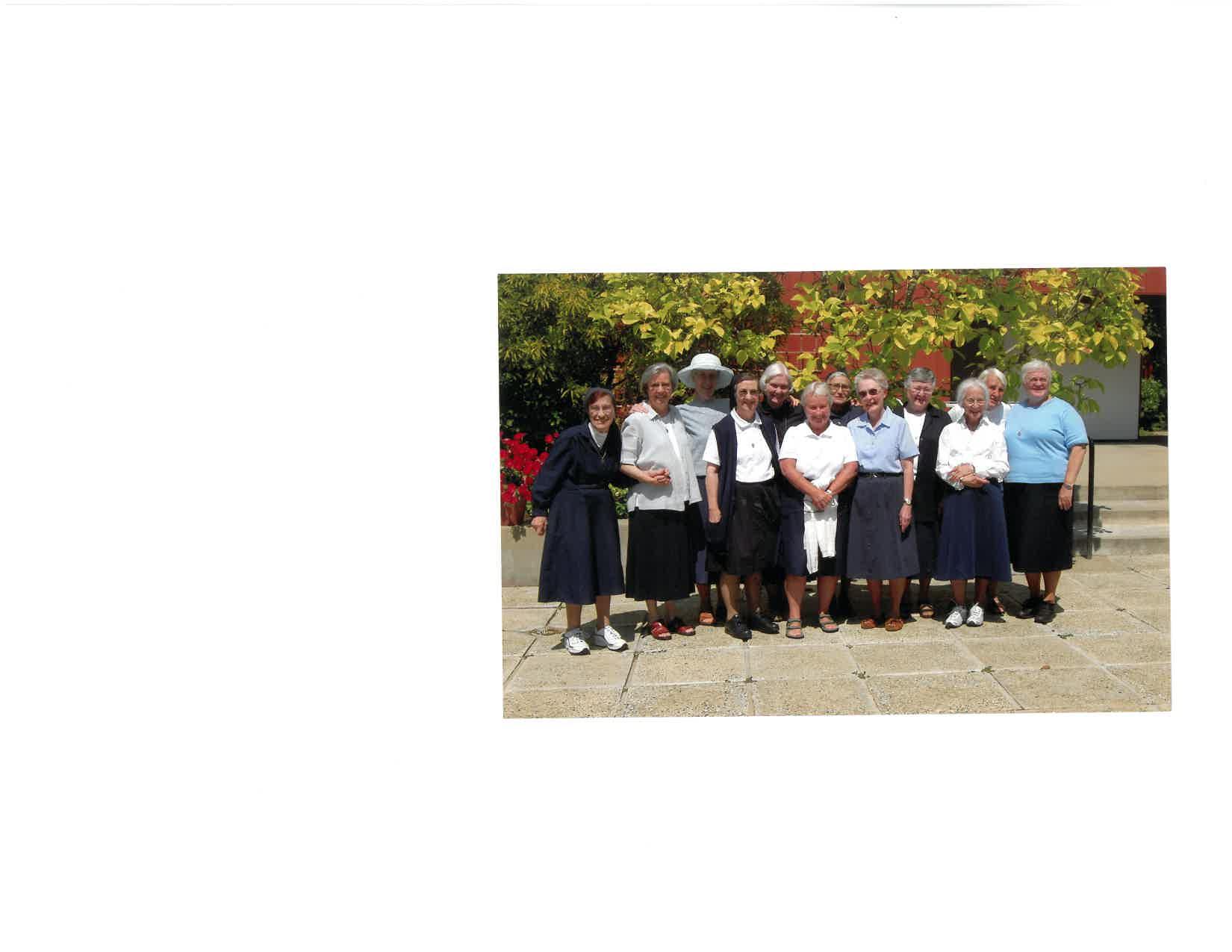
32 minute read
The Band of 1958 Daughters of Charity on the Journey of a Lifetime
by Anna M. Ross
“BAND”: It’s a familiar word with a variety of meanings. In biblical terms, a “band” joins forces to ward off oppressors. A “band” is also a musical ensemble, musicians in harmony creating a beautiful piece. The rubber “band” is an elastic loop that winds and wraps to hold parts together. A “Band”Aid covers and protects until a hurt is healed. The wedding “band” signifies strength with its precious metal and eternal love with its circular design. Another type of “band” embraces all the meanings above yet is unfamiliar to many. This “band’s” significance relates to a time and place in the lives of a group of young women who came to Normandy, Missouri in 1957, in answer to a call: to become a Daughter of Charity of St. Vincent de Paul. Each woman arrived separately, but nine months later, they were a unified body, ready to take the next step in their vocation journey. They walked to the Seminary, where they would spend the next year. On June 5, 1958, Feast of the Sacred Heart, they were admitted into the Company of the Daughters of Charity – and now forever known as the “Band of 1958.”
Advertisement
Sixty-three years later, 13 Sisters remain of the band. Ten Sisters were interviewed in person, by phone, by email. Five spent an afternoon together in Evansville, Indiana, sharing their reflections. Some stories had shifted, from worrisome foibles to amusing anecdotes. Others were perhaps too painful to recall, tucked deep within, handed over to God years ago for safekeeping.
An Afternoon to Remember
(L to R): Sisters Jane Burger, Angele Hinkey, Barbara Dingman, Karen Flaherty and Sharon Groetsch revisit their early years, courtesy of Sister Angele’s photo album.
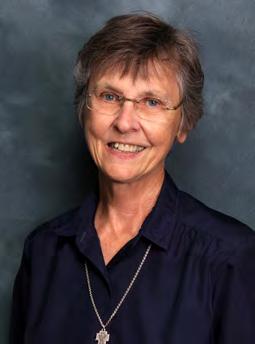
On September 25, 1957, thirty-eight young women arrived at Marillac Provincial House; eager, excited, a bit anxious yet relieved to have finally said their goodbyes. Months ago, these women had been scrutinized and interviewed by those who knew best the discipline a vocation would require. They had been questioned and teased by those who doubted their commitment. Some would wonder whether they had truly been called to this life; a life admired by some, a self-sacrifice to most. Would their journey end before it had even begun? Arrivals took place throughout the day; a hive of activity as the Habit Sisters prepared to accommodate the largest group of postulants they had ever had (or ever would). Some arrived by car filled with the whole family, such as Sister Barbara Dingman, oldest of seven and second mother to a brood of four babies, including a two-month-old boy. The family lived a short distance from Marillac, often trading visits between Sister Sylvia at Marillac and the Dingman home. A good friend and helper to Sister Barbara’s mother, it was Sister Sylvia’s recommendation – her first and only one – that facilitated Sister Barbara’s acceptance as a postulant. Sister Carol Hoelscher (left) also was from St. Louis and familiar with the Daughters after working as a college volunteer at Guardian Angel Settlement. She recalls as a little girl walking with her father and seeing Daughters in their habit and winged cornette waiting for the streetcar. Fascinated, she said to her father, “Daddy, who are those people?” Sister Carol’s family dropped her off at Guardian Angel Settlement on arrival day, with her father meeting the Daughters who’d take her to Marillac. “My father became a ‘convert’ that day to the Daughters,” she recalls. “From then on, he was their champion!” Sister Sharon Groetsch flew to Lambert Airport from New Orleans alone, the cost of airfare too steep
for her large family. Sister Sharon (right) had been taught by the Daughters of Charity in grade school and recalls her excitement as she was driven to Marillac. “I couldn’t wait to become a teacher, to become a Daughter. And that joy in realizing my purpose according to God’s plan has never changed.” Sister Jean Maher arrived by train from Wisconsin, also alone. An only daughter with three brothers, Sister Jean made her decision to become a Daughter on the Feast Day of St. Louise, then recognized on March 15. “But,” she says today, “I waited until St. Patrick’s Day two days later to tell “And that joy in my family, hoping a more festive realizing my purpose occasion might soften the blow.” A long pause. “It didn’t.” according to God’s Sister Jean remembers how she plan has never pictured life as a Daughter or, rather, changed,” she says the steps necessary to become one. today.” “I think I got through those early years because I had youth on my side,” she says reflectively. “I also had - Sister Sharon Groetsch the openness to accept how things would be done, even if I didn’t necessarily agree with them.” A little laugh, before admitting, “I also thought that I would never smile again.” Riding in the car to Marillac with her family from their hometown of Jasper, Indiana, Sister Jane Burger recalls most the silence. “I think we all were grappling with the idea of my decision: the strictness of the Daughters, not knowing the Daughters as we did the Sisters of Providence who had taught us and, most importantly, the realization that I could never go home again.” Sister Angele Hinkey (right) from Chicago was the last to arrive, having told her parents, “If you bring me, I won’t be able to make it through the doors.” Instead, her brother, his best friend and the family priest brought her. But the foursome cut the trip a bit close, arriving at Marillac just as the doors were closing.
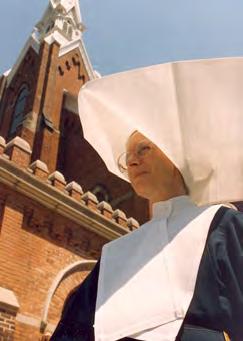
Sister Angele recalls that “I made it inside just as the grandfather clock chimed 6:00 o’clock. Everyone was already seated at the dining tables saying prayers. They were in postulant dress – an all-black skirt, blouse, stockings and shoes, and a black cap with lace on the outside and two ribbons in back called the dignity. And here I am,” she says with a laugh, “standing there in a pleated skirt and 3-inch heels!”
The women were taken to an annex of Marillac Provincial House, where for the next nine months they would live in community. It would be a time of discovery, of learning what it meant to become a Daughter of Charity. As a group, they would follow a daily schedule, sleep in dormitories, eat meals, recite prayers, study founders St. Vincent de Paul and St. Louise de Marillac, and perform household duties. They would learn the meaning of an apostolic community – a community that asked of them to “go out and be of service to the poor.” It wasn’t long before this sense of community took hold among them. One day on their way to chapel, a pact was made to pray every Thursday for one another. Just who suggested the idea has long since faded from memory, but 63 years later, each is fully aware that every Thursday, she has a promise to keep.
As postulants (called Miss with their surname), they would attend the newly opened Marillac College (1955) for two semesters. Founded by the Daughters of Charity through the
efforts of Sister Bertrande
Meyers (left), who became its first President and Dean, the Catholic Sisters’ formation college provided a top-notch liberal arts education (accredited in 1960) and full four-year bachelor’s granting program. It also was instrumental in shaping future sisters and nuns in their spiritual formation. Over 25 women religious orders and communities would be represented in the student body, with 15 represented on faculty. Each of the newly arrived young women, ranging in age between 18 and 22, brought to Marillac her own unique personality, from the outgoing to the chatty, to the shy. While some came from urban cities such as Sister Germaine Sarrazin from Los Angeles and Sister Angele Hinkey from Chicago, others came from small farming communities such as Sister Germaine Price (below) from Stockbridge, Wisconsin.
Sister Germaine recalls growing up on a farm with four brothers and three sisters and how neighbors would gather in times of need. It was this spirit of community that enabled Sister Germaine to realize the importance that one had for another that a shared life brings. She recalls her arrival at Marillac, knowing no one and feeling a bit lost. She went to the basement and “a Sister greeted me by name,” Sister Germaine relates, still impressed today. “And right then, I knew I belonged.” Sister Jane Burger remembers hard work and good times spent with her family in Jasper, Indiana. Outgoing, active and “very gregarious like both my parents,” she had been taught by the Sisters of Providence in grade school. But it was at St. Vincent Nursing School in Indianapolis, run by the Daughters, where she discovered where her vocation would lead her. At a retreat there, Sister Jane recalls, “The Scripture spoke powerfully to me, personally”: For my thoughts
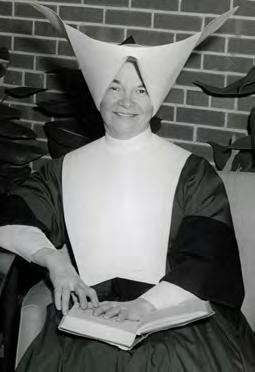
- Sister Germaine Price

are not your thoughts, neither are your ways my ways,” declares the Lord. As the heavens are higher than the earth, so are my ways higher than your ways and my thoughts than your thoughts (Isaiah 55-8-9).
When the hospital chaplain asked her, “in which Community would you be helping the Church?” Sister Jane’s answer was immediate: “The Daughters of Charity.” Drawn to their commitment to serve the poor and after reading a book on the life of St. Louise de Marillac, Sister Jane waited until after her sister’s wedding in April to tell her parents and friends of her decision to enter. “Nobody believed me when I told them,” she says today with a smile. Sister Judith (Jude) Hebert, the youngest of six with four brothers and a sister, arrived from Boston, Massachusetts, the only Sister in the band from the East. She relates “while I didn’t know any Daughters personally, I would watch them from my high school window with the schoolkids on the playground. I admired how they related to the children in a very human and caring way.” Sister Judith’s decision to enter, however, was met with a sense of skepticism and a bit of innocent gambling: “Friends and neighbors were taking bets on how long I would last, the longest being six weeks!”
The last postulant to arrive and two weeks later was Sister Germaine Sarrazin (left) from
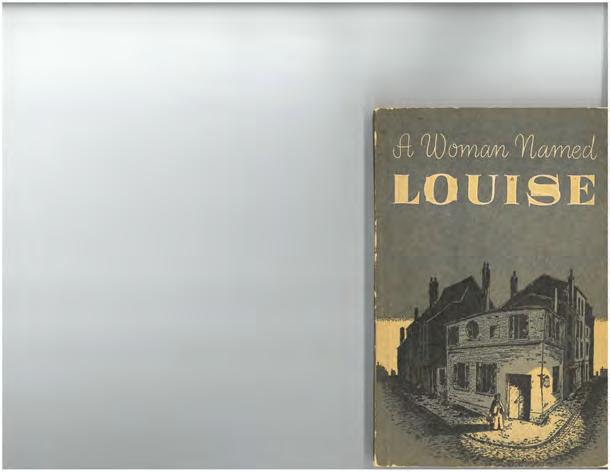
California, delayed because of an emergency appendectomy. (Sister Germaine is one of three Daughters in the band who eventually joined the Province of the West in Los Altos Hills, California.) Her late arrival meant she couldn’t start college with the others, but quickly fit in with the group, whom she called “warm and welcoming.” Sister Germaine realized she belonged with the Daughters after much prayer and a few choice words with God. Arriving early for high school choir practice, she would stop first in the chapel to pray, the prayer never varying: “Here I am, Lord – and I have no idea what I want to do.” She admits to having a few arguments with God about His ideas for what she should be doing and her thoughts on them. In the end, God won. When she told her parents of her decision, both were fully supportive, especially her father. “He had a gruff voice and a teddy bear heart,” she recalls, continuing, “and would boast to anyone and everyone about his ‘Daughter daughter.’” Some parents opposed their daughter’s decision, primarily because of the rule that they could not go home. It was this rule, echoed by nearly all today, that “caused the most pain – and our parents’ greatest sacrifice.” It would be another 12 years before Daughters could stay with family on home visits. This sense of permanent separation from one’s family is difficult for any parent to accept. Sister Jean Maher’s mother remained adamant in her opposition, letting her feelings be known in her letters to Sister Jean. “The Visitatrix finally spoke to her, saying how upsetting her letters were to me,” Sister Jean recalls. “But,” she admits with humor, “I was asked if I could write something more interesting than the daily menu and what I had had.” For some who first realized a call to religious life, it was as if by chance – or God’s will – that directed them to the Daughters of Charity. Sister Bertrande Meyers at Marillac College played a crucial role in encouraging young girls to consider a vocation, sending magazines such as “Sacred Heart” and “Jubilee,” and her book, “A Woman Named Louise,” to provide insight into the community’s charism and their foundress. Sister Karen Flaherty (below), from St. Edward, Nebraska, speaks of Sister Bertrande’s influence on her. With no Catholic grade school in St. Edward, Sister Karen’s Catholic faith entailed “church on Sundays and two weeks every summer at a Bible camp.”
When the family moved to Lincoln, Sister Karen attended Cathedral High School, and it was as a junior that she and her classmates heard from Sister Bertrande. “The girls were asking one another if they’d received anything in the mail.”
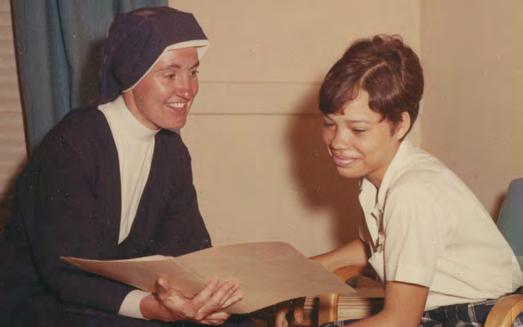
Sister Karen recalls. “I wrote her back and we began exchanging letters. I told her I wanted to be a teacher like my mother and that I wanted to travel. After two years at the University of Nebraska, I went to St. Louis to meet her. “While there, I visited St. Patrick School and stayed at St. Ann’s Parish. I saw for myself the great needs of those living on the margins and how as a Daughter, I could serve. I decided becoming a Daughter would allow me to teach and to serve the poor,” she says today. Her love of travel would also be realized; always ready to go no matter where or when. Sister Sharon Groetsch’s deep respect and love for the Daughters of Charity began in second grade with her teacher, Sister Margaret Quinn, D.C. “She captured my heart,” Sister Sharon says, and “when discerning my vocation, I focused on the Daughters and the Vincentian spirit of their charism. My parents only asked one question: ‘Is becoming a Daughter of Charity going to make you happy?’” Sister Sharon says today, “I never had a second thought about becoming a Daughter. But I’ve never forgotten walking to the plane the day I left home, turning back to wave at my dad. I yelled to him: “Dad, you take care of yourself. And take care of Mom.”
Like Sister Karen Flaherty, Sister Judith
Hebert (left) also found her vocation as a Daughter of Charity through the efforts of Sister Bertrande. “Since I knew no Daughters,” she relates, “I reached out to Sister Bertrande after receiving some literature from her. We began corresponding, and I entered at Marillac Provincial House in Normandy.” Sister Judith finds humor in what she anticipated her ministry to be when she entered, recalling, “I was attracted to the Daughters because I thought I wouldn’t have to teach. And what happened? I landed in the classroom for over 20 years!” Today, she writes, “It has all been God’s plan.” Following her teaching ministry, Sister Judith served in social justice ministries, her last ministry at a jail where, “I visited women, listened and prayed with them and conducted prayer services. And as I look back, it is clear each ministry experience prepared me for the next.“ For Sister Germaine Price, the call to serve came from a single line in a Catholic newspaper. Living in a college town 35 miles away from the farm and sharing a house with several other working women, Sister Germaine was determined to save money and get her teaching degree. “My mother would send me the Catholic newspaper, she recalls, “and one day, there was a line that just popped out at me, that asked: ‘How would you like to serve the poor?’”
Sister Germaine began corresponding with Sister Bertrande and finally returned to the farm. She wrote her thoughts out, leaving the sheet on the kitchen table for her parents and waiting outside for their response. When Sister Germaine said she was going to visit St. Louis, her mother insisted on accompanying her. It was the first time Sister Germaine had ever been out of Wisconsin. Sister Germaine eventually earned her teaching degree – not as she planned but God had – traveling
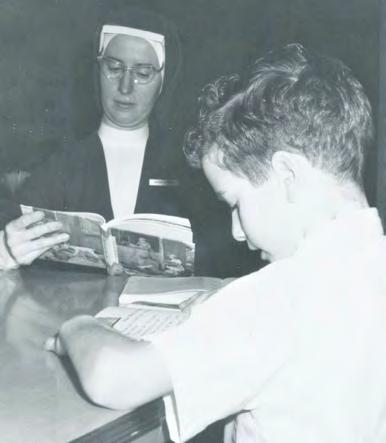
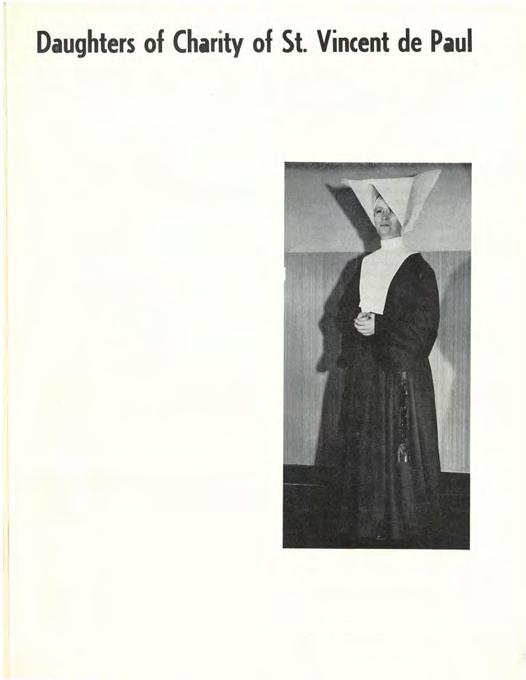
far from Wisconsin and the farm she loved. Yet the farm remains her compass; filled with gratitude for the grounding it gave her and the spirit of community it taught her. Sister Angele Hinkey from Ottawa, Illinois, had been considering the Daughters of Charity for five years, having learned of the Daughters from a Sister of Mercy at her high school. Sister Angele began corresponding with Sister Bertrande but remained uncertain. “After high school, I went to the Ringling Brothers Art School (now Ringling College of Art and Design) in Sarasota, Florida, for a year,” she relates. “But once home (May 1957), I felt this ‘gnawing of the heart,’ that kept growing more dominant,” Sister Angele recalls. “One day, I went to my favorite place in the world – the Illinois River – and set out in my canoe. I asked myself, ‘How can I ever give this up?’ And in that moment, I knew that I could give up my river and my family for something greater. God gave me the grace to realize – and to accept – that my life would be for many, not just for myself, not with a family of my own. That moment was my miracle.” Sister Barbara Dingman’s (below) family was one of the poor families visited by Sister Sylvia, the former secretary at Marillac who years earlier would visit her mother’s family when her mother was little. Sister Barbara’s desire to join the community grew stronger during her teen years at Labouré High School, and with the support of her parents, she was accepted. “I thought with all my experience in looking after my younger siblings, that I could serve in childcare,” she says today.
Although childcare was her initial intent, Sister Barbara would later find her greatest reward serving in the inner-city neighborhood assisting the elderly. Today, she serves her senior Sisters, still protective, still mothering with a nononsense approach, a razor-sharp mind, and a very large heart.
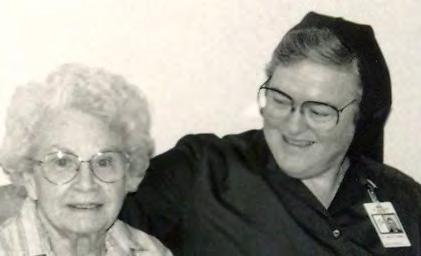
The Seminary
Following Vocation Day held on June 5, 1958, the former postulants (now numbering 30) walked across the front courtyard of the Provincial House to the other side of the building to the Seminary. It was here that the band would learn the true meaning of living in community, growing together from separate parts to become a whole. It was here they would become Daughters of Charity from within, shaped by the discipline of silence, the scrutiny of self, and a confidence in the guidance of God who had chosen them. Cloistered and no longer attending college, recreation was now limited to 30 minutes twice a day with three to a bench. However, every Wednesday afternoon an exception was made with an outdoor picnic: freshly baked bread, peanut butter and jam – and a chance to talk! As Seminary Sisters, attire was a simple black dress with a fichu (piece of white cotton worn like a shawl), a white bonnet with starched sides, and a capot (a hood-like piece worn over the bonnet). A chaplet of brown beads on a white string and simple cross was worn on the left side.
Even in the silence, the Sisters were always together. And perhaps because the Seminary was so restrictive in its movement and rigid in its order, those from the band could easily recall the moments when discipline of mind and body briefly made their escape to laugh out loud. One such moment was when Sister Angele was scrubbing a huge coffee pot. With her petite height (her mother told her that she had brought the four-pound baby home in a shoebox), it seemed inevitable that one day she would fall in. Harry, the baker, grabbed her by the ankles and lifted her to the rim; then climbed down, without saying a word. In the retelling, the mirth remains as fresh as his baked bread on Wednesdays. Sister Carol Hoelscher sat in the middle of the bench during recreation, bemused by her chatty and her reserved bench mates. Sister Carol often heard the Seminary Sisters mention their fear of being sent home. “While there, I was thinking God was going to tell me it was time to go home.” Sister Germaine Sarrazin remembers rabbit soup, which was leftover chocolate rabbits from Easter, melted and mixed with milk to make hot cocoa.
More than 60 years later, the surprising treat remains a tasteful Seminary memory. Sister Sharon Groetsch also afforded her band Sisters a fond Seminary story. A Southern transplant to the Midwest (the youngest of nine and a bit spoiled, she says), Sister Sharon struggled to keep up with the fast pace of Seminary life. One afternoon, she told the Directress, “I’m just too tired.” Unimpressed, the Directress told Sister Sharon “she should go to bed.” Since it was only 4 o’clock, Sister Sharon slept through supper and evening prayers, only waking up when her Sisters returned. She got out of bed and put her habit on. And her dormmates response? “Go to bed.” Although the Seminary year might seem daunting to an outsider, several of the Sisters said how much this year would mean to them, discovering in the silence “that one could hear the voice of God.”

Sister Jane Burger (left)
said, “I loved the Seminary experience because of the clarity that God was giving me.” Like Sister Jean Maher, she remembers being open to whatever was asked of her. While some rules were a challenge to accept, Sister Jane remembers knowing “that this time was only temporary, a preparation for who I would one day become.”
For Sister Angele Hinkey, the Seminary was one of “sacredness, of becoming a part of a community with whom I would always be connected. And I realized from the silence how my relationship with God was deepened,” she says reflectively. “I witnessed the spirit of being a Daughter of Charity as partly active, partly contemplative, but both so integral to formation. We needed to meld the active charism of service and mission with the contemplation of the spirit of God in our community.” Sister Jean Maher (top right) remembers Postulatum and the Seminary days as one of ambivalence, “knowing I was causing pain to someone I loved, my mother.” She recalls Thomas Merton’s book, “Seven Storey Mountain,” and his struggle toward finding the interior peace of God after withdrawing from the outside world. At Gethsemani Abbey, Merton “found the four walls of my new freedom”; an ideology that spoke to Sister Jean. “It was only when I was finally sent on mission, that all my ambivalent feelings disappeared. I knew I was who I needed to be,” Sister Jean says.
Sister Karen Flaherty’s enthusiasm for a life as a Daughter never dimmed, whether it was during her days in the Seminary or on mission traveling to parts unknown. She shares “the excitement of being led by God. I knew that He was offering me a gift, and I knew His was a gift I could not squander.” Sister Karen was missioned to New Orleans in 1961, where for the next 11 years, she would serve as a high school counselor, assistant principal and teacher. But she would step outside the classroom, undertaking with joy ministries such as the Learning Clubs and Outreach Endeavors.
One of Sister Karen’s most memorable missions was in 2011 when she was in her seventies. When Sister heard the Most Honored Father ask: “Can’t somebody go to Kenya?” she thought to herself: “Well, I can!” And she did.
Sister Karen spent six years in Kitale, Kenya teaching art to young students. One of her most cherished memories was being invited to a student’s house for dinner. “When I walked in,” she relates, “there, hanging on the walls, were all her student’s paintings. It was so beautiful, and the parents so very proud. It was such a joy-filled time for me.”
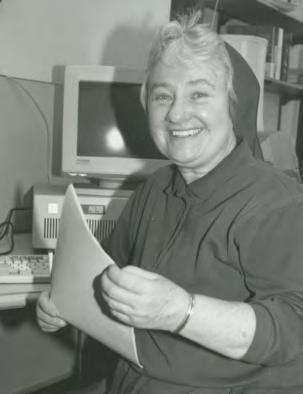
First Vows 1963 – Daughters of Charity on Mission
At the end of the year in the Seminary, the Band of 1958 numbered twenty-nine. Each Sister would submit in writing to the Visitatrix the request to “be sent in mission.” They would begin wearing the habit of the Daughters and be called Sister with a first name. Sister Jean Maher recalls that they could submit three names; however, that didn’t mean they would get any of them (Sister Jean didn’t).
Others asked – and were allowed – to keep their baptismal names. (Eventually, for legal purposes, all Daughters would use baptismal names). Sister Jane Burger, for one, was relieved, revealing, “I don’t think God knew who He was talking to when I was called ‘Leola’!”
Following Seminary year, some band Sisters remained to complete their education at Marillac College. Others, like Sister Carol Hoelscher, who had earned her bachelor’s degree before entering, were sent on mission. Even before she had made her decision to become a Daughter, Sister Carol knew that teaching wasn’t her calling. As fate would have it, an emergency came up and a first-grade teacher was needed at a grade school in Illinois. Sister Carol was caught unawares, unprepared to teach, especially not 50 first graders. Having been placed in the one ministry she had never desired, Sister Carol would spend the next 23 years as a teacher, often asking God if she was really doing His will. Sister Carol went on to teach high school, enjoying the older students and their enthusiasm in her classes. She remembers a compliment from a high school senior who exclaimed: “Hamlet’s just like watching a soap opera!” However, she still speaks gingerly of her first class, saying “I still pray today for each one of them.” Sister Angele Hinkey attended one year at Marillac College after Seminary, then was missioned to Chicago in 1960 where she would earn her Associate Arts degree. She returned to Marillac in 1963 to make First Vows with her band. Then, after 30 years in social service ministries, Sister Angele returned to her first love: the world of art (Faith Afire Winter 2021).
Today, Sister Angele says, “I feel blessed by my art ministry, helping female inmates discover themselves through painting.” Since the pandemic, Sister Angele has been serving at Maximillian Kobe House in Chicago, hoping to one day soon return to the “greatest artists I have been privileged to know.” Sisters Germaine Price and Germaine Sarrazin traveled by train together in 1962, both with teaching degrees to begin their ministries. Sister Germaine Sarrazin recalls her amusement when the train stopped at Sister Germaine Price’s first mission – in Price, Utah. Sister Germaine Price would only be in Utah a year, but it was here, at her first school, that she experienced the power of community. “I was given a different subject to teach than what I had earned my degree in, the switch made out of respect for the feelings of another. And I discovered I loved the new subject even more!”
60th Jubilee Reunion 2018 (Front row, L to R): Sisters Angele Hinkey, André Aycock, Jane Burger. (Back row, L to R): Sisters Sharon Groetsch, Carol Hoelscher, Judith Hebert, Barbara Dingman, Germaine Price and Karen Faherty. (Missing: Sister Jean Maher left early).
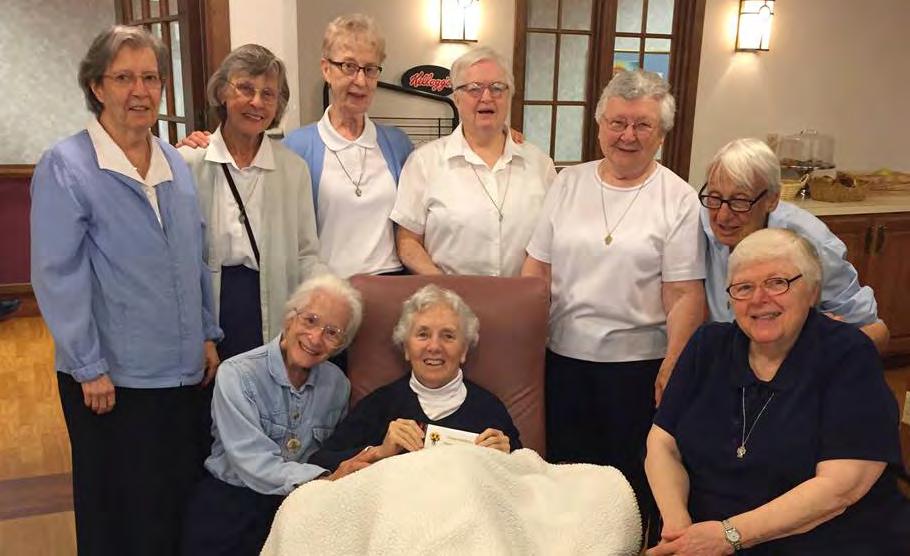
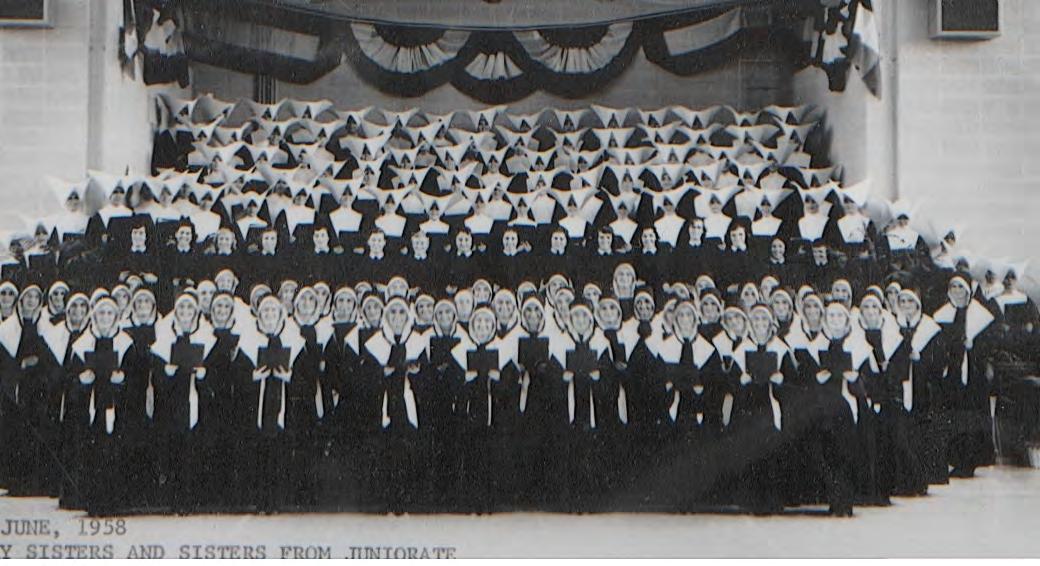
Sister Germaine Price’s first mission outside the United States was to Puerto Rico, then later, Haiti, Istanbul, Burundi, Africa, and Bucharest, And her feelings about these foreign missions? “I loved every minute, wherever I was sent. I received so many blessings from God; He gave me what I needed at that moment, whether it was grace or the awareness of His presence within me.”
The rhetorical question of “How blessed has my life been?” assures one that Sister Germaine Price’s life has indeed been bountiful. One of her greatest blessings, she recalls, took place in Bucharest, Romania, where thousands of HIV-Positive children lay on hospital beds, abandoned by their parents. Sister Germaine, with wonder in her voice, recalls, “I had the privilege of accompanying these poor young souls in the dying process. And as I held them, for the first time in their short lives, they knew the meaning of love.” Sister Germaine Sarrazin would return to California and become a part of the Province of the West in Los Altos, California. But after serving three times for a total of 30 years in Utah, she feels comfortable calling this beautiful state home. A first-grade teacher for 40 years, Sister Germaine speaks affectionately of her young students. “I’ve had many a first grader come up to me and say, ‘Well, I have always known how to read!’”
In 2003, Sister Germaine Sarrazin retired from the classroom, recalling: “I didn’t want to be the person that someone has to tell that it’s time to go.” She still teaches at an after-school program, helping the
children of those whom she taught so many years ago. She describes her life as a Daughter of Charity as being one of gratefulness: “God has given me so very much,” she says, adding, “What blessings I have had!” The band would reunite on March 25, 1963 at Marillac to take their First Vows on the Feast of the Annunciation (an annual renewal of vows that takes place for all Daughters around the world). And for Sister Jane Burger, the ‘60s and ‘70s would be a time of “sweeping change in the church, in the
community, and in society.” The social conscience of a nation was stirring, awakening a slumbering collective consciousness that dared the young and the old to challenge the status quo. In 1957, the year the band arrived at Marillac, there were already rumblings of change. Martin Luther King Jr., still relatively unknown on the national stage, spoke twice in St. Louis. To the crowd in Kiel Auditorium, Dr. King pricked their social consciences, giving voice to meaningful action. On August 28, 1963, just five months after the band had made their First Vows, Martin Luther King Jr. delivered his “I Have a Dream” speech in Washington, D.C. The powerful message of to “one day live in a country where my children would not be judged by the color of their skin but by the content of their character,” was mirrored in the charism of the Daughters and those of the Band of 1958. Pope John XXIII succeeded Pope Pius XII upon his death in 1958, and although his papacy would be short-lived (1958-1963), his convening of Vatican II in 1962 transformed the Catholic Church with sweeping reforms both from within and without. He challenged a society and a Church that refused to accept the truth of God’s creation: “We are all made in God’s image.” It was a call to holiness, to becoming an ecumenical apostolic and inclusive interfaith society.
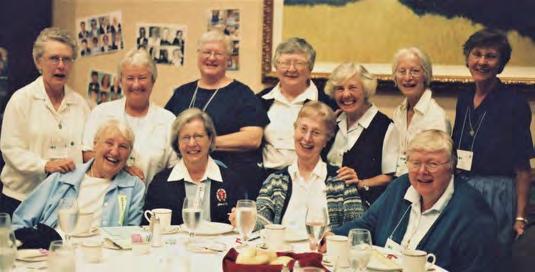
It was a call that echoed the sentiments of Daughter of Charity Blessed Sister Rosalie Rendu (1786-1856): “Hunt down poverty in order to give humanity its dignity.” And the Company of the Daughters of Charity, like the Church and society, would experience its own awakening in the 1960s. From the replacement of the cornette to the coiffe in 1964, to changing and updating the Constitutions, to placing a greater emphasis on formation, spiritually and professionally, the Daughters of Charity were witnesses to and a part of the vision for a new world, the Great Society. Today, the Sisters in the Band of 1958 continue to serve, carrying out their ministries with the same dedication as they were called to do so many years ago. Sister Jean Maher has been in Harlingen, Texas since 2020, where she educates, engages and empowers under-served families in South Texas. She also serves at the Culture of Life Ministries in Harlingen, a healing health-care organization that addresses the health needs of the community. Sister Germaine Price continues to embrace the spirit of community, currently assisting at the Suds of Love program at St. Vincent’s Parish in St. Louis, where once a month, those in need are provided with quarters and detergent to wash their clothes. They and the volunteers form a community, sharing in the importance of human dignity to one’s soul, the basic need for human contact. Sister Germaine also lives at the Seminary, located in the city. Currently, there are five Sisters at the Seminary who wonder, as Sister Germaine’s band did so many years ago, if they, too, have been called. Sister Carol Hoelscher serves at the front desk of the St. Louise Province Office in St. Louis. She often listened for His voice during her earliest years, waiting for His permission to leave. But her daily acts of kindness, her thoughtful care of each person who enters the office, her unfailing good humor, offer tangible proof that God remained silent for a reason. He knew where – and to whom – she belongs. Sister Jane Burger remains as she did as a young postulant – active, gregarious, unafraid to take a stance against injustice. She is, most importantly, a grateful Daughter who accepted “the Lord’s invitation to follow Him.” She, like many in her band, have conquered the challenge of learning a new language – technology – with all its clicks and dings. Sister Jane currently serves as Vincentian Spiritual Advisor for the Evansville Ladies of Charity. The Daughters of the Band of 1958 speak of living a life of privilege, not one of sacrifice as some might assume. Never worldly, but very much a part of the world, they’ve sought the success of those whom they serve, those they have taught to hope, to experience compassionate love. Eighteen Sisters left the community in the years following the band’s First Vows in 1963. None of those who remained questioned why; rather, mourned the missing piece of their whole. Four Daughters of the band are deceased, most recently Sister Annette LeDuc, who passed away in 2020. Sister André Aycock
(left) could not attend the interview in Evansville, but her name readily evokes a smile and a story. From Lockport, Louisiana, the only girl with five adoring brothers, Sister André served as a nurse throughout her years on mission. Her free spirit, quick wit and wonderful sense of humor, traits agreed upon by the group, were on full display during her days at St. Mary’s Hospital in Taiwan – pulling up each morning on her motorcycle. All the Sisters of the Band of 1958 (as did the bands who came before and after) left loving families, parents who made the sacrifice to let their daughter go and siblings too young to understand. Sister Carol Hoelscher recalls taking her little sister and carrying her everywhere when she was small. When the family dropped Sister Carol off, she recalls thinking: “I wonder if she understands why I am leaving.” Sister Barbara Dingman’s mother died in 1970, and Sister Barbara by good fortune was at Marillac College, finishing her bachelor’s degree. “When my mother died, my father was alone, doing his best to care for four teenagers – all in high school! I helped out when I could, but I know it was a trying time for him,” she says. Sister Jean Maher’s mother never gave up hope for her return home. After her mother died, Sister Jean looked around the empty house, thinking, “There’s nothing that I really wanted, no things that I wanted to take. So, I took one of her plants, later worrying that if the plant died, it would be like Mother dying all over again.”
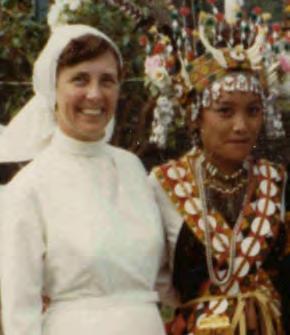
The plant flourished, growing so big that Sister Jean couldn’t take it on her next mission. And although Sister Jean had never considered leaving the community, she received a phone call from her sister-in-law who said, “This will always be your home and you are always a part of this family.” Sister Jean hesitates in the retelling, saying quietly: “I don’t think I ever told her how much I appreciated those words.” But with her mother’s plant, sturdy and standing on its own, and a phone call to remind her that she will always be a part of the family. Sister Jean realized that her mother is with her still, speaking to her through God with a love that sets both free: “You are right where you belong.” Sister Jean’s band knows that she belongs with them, too. They have belonged to one another since September 25, 1957. They never forgot their first families; God simply widened their hearts to hold a second. Theirs has been a band as strong as precious metal and as eternal as a ring’s design. A band whose fidelity to one another was pledged 63 years ago: “Every Thursday, we will pray for one another.”


Top two photos: The Sisters always took time to pose for a group photo whenever they gathered.
2009: A Golden Reunion in the Golden State (L to R): Sisters Annette LeDuc (dec.); Sharon Groetsch; Judith Hebert, Germaine Sarrazin (West); Margaret Ann Gainey (West); Jean Maher; Evelyn Candelaria (West); Linda Delery (dec.); Germaine Price; Angele Hinkey; Karen Flaherty; Barbara Dingman.
